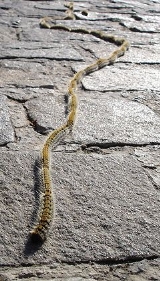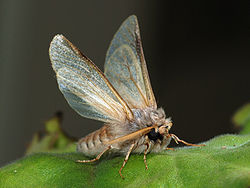
Pine Processionary
Encyclopedia
The Pine Processionary http://pin.processionnaire.com/ is a moth
of the family Thaumetopoeidae
. It is sometimes placed in the genus Traumatocampa. It is an abundant species of pine
woods in central and southern Europe
.
 It has cream coloured forewings with brown markings and white hindwings. The species flies from May to July. The larva
It has cream coloured forewings with brown markings and white hindwings. The species flies from May to July. The larva
is a major forest pest
, living communally in large "tents", usually in pine trees but occasionally in cedar or larch
, marching out at night in single file (hence the common name) to feed on the needles. There are often several such tents in a single tree. When they are ready to pupa
te, the larvae march in their usual fashion to the ground, where they disperse to pupate singly on or just below the surface. The larvae should never be handled as the abundant hairs on their bodies cause extreme irritation to the skin.
Studies have been conducted on the processionary pine where a group of them were attached nose-to-tail in a circle with food just outside the circle. After a week of marching in circles the caterpillars died of starvation and exhaustion.
Moth
A moth is an insect closely related to the butterfly, both being of the order Lepidoptera. Moths form the majority of this order; there are thought to be 150,000 to 250,000 different species of moth , with thousands of species yet to be described...
of the family Thaumetopoeidae
Thaumetopoeidae
Thaumetopoeidae is a small family of moths in the order Lepidoptera. The genera in this family have been historically treated as a subfamily within Notodontidae instead....
. It is sometimes placed in the genus Traumatocampa. It is an abundant species of pine
Pine
Pines are trees in the genus Pinus ,in the family Pinaceae. They make up the monotypic subfamily Pinoideae. There are about 115 species of pine, although different authorities accept between 105 and 125 species.-Etymology:...
woods in central and southern Europe
Europe
Europe is, by convention, one of the world's seven continents. Comprising the westernmost peninsula of Eurasia, Europe is generally 'divided' from Asia to its east by the watershed divides of the Ural and Caucasus Mountains, the Ural River, the Caspian and Black Seas, and the waterways connecting...
.

Larva
A larva is a distinct juvenile form many animals undergo before metamorphosis into adults. Animals with indirect development such as insects, amphibians, or cnidarians typically have a larval phase of their life cycle...
is a major forest pest
Pest (animal)
A pest is an animal which is detrimental to humans or human concerns. It is a loosely defined term, often overlapping with the related terms vermin, weeds, parasites and pathogens...
, living communally in large "tents", usually in pine trees but occasionally in cedar or larch
Larch
Larches are conifers in the genus Larix, in the family Pinaceae. Growing from 15 to 50m tall, they are native to much of the cooler temperate northern hemisphere, on lowlands in the north and high on mountains further south...
, marching out at night in single file (hence the common name) to feed on the needles. There are often several such tents in a single tree. When they are ready to pupa
Pupa
A pupa is the life stage of some insects undergoing transformation. The pupal stage is found only in holometabolous insects, those that undergo a complete metamorphosis, going through four life stages; embryo, larva, pupa and imago...
te, the larvae march in their usual fashion to the ground, where they disperse to pupate singly on or just below the surface. The larvae should never be handled as the abundant hairs on their bodies cause extreme irritation to the skin.
Studies have been conducted on the processionary pine where a group of them were attached nose-to-tail in a circle with food just outside the circle. After a week of marching in circles the caterpillars died of starvation and exhaustion.

